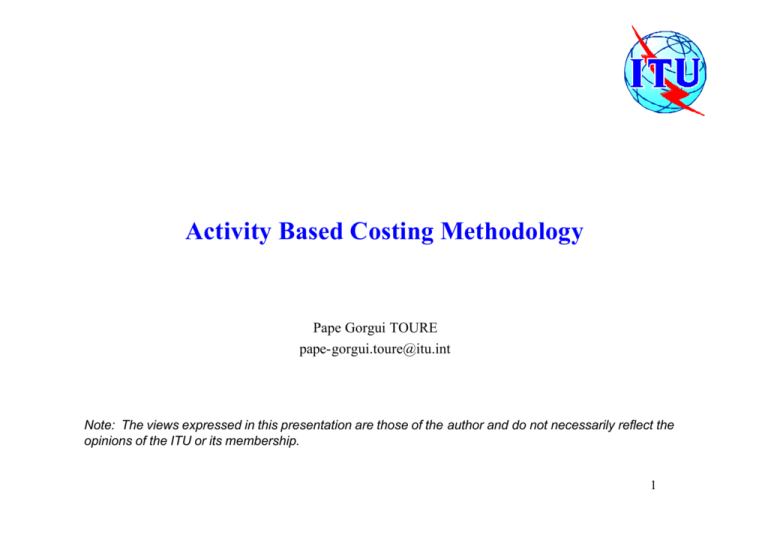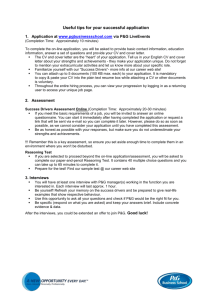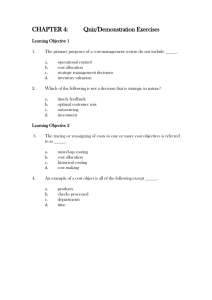Activity Based Costing Methodology
advertisement

Activity Based Costing Methodology Pape Gorgui TOURE pape-gorgui.toure@itu.int Note: The views expressed in this presentation are those of the author and do not necessarily reflect the opinions of the ITU or its membership. 1 Cost Types A product/service has usually three types of cost: – The direct costs, the – Indirect costs, and the – Common costs 2 Direct Costs • Are traceable directly to the product, • The resources to which the costs are associated are usually totally assigned to the product, • There is neither ambiguity nor difficulty to assign the costs to the product 3 Indirect Costs • Are identified for the product, • The resources to which the costs are associated are usually shared with at least one other product, • The allocation of the cost require some calculations, • I.E : billing costs 4 Common Costs • Are not traceable to a given product • The resources to which the costs are associated are usually share by several products, • There is no simple mechanism to allocate the costs to those products, • I.E : overhead costs 5 “ABC” • Activity based costing • “ABC” is a cost allocation method (not a cost concept); • It can allocate indirect and common costs to given products when those costs are related to consumed resources 6 Activities and business processes • Activities are the work that employees do • to understand that work, identify the output that each group produces and the resources that the group is assigned • linking the flow of outputs between groups helps an organisation understand its business processes 7 Activity analysis • Is the identification and description of activities in an organisation • helps an organisation to plan desired outcome • forces an organisation to identify any gap between current performance and desired outcome and adapt the resources (cost saving) 8 Major components of an activity • The definition of the activity-what is actually being done; • the output - what is actually produced; • the work load measure - what drives the work load; • the customer or customers of the activity - i.e., who receives the output • the inputs - i.e., what triggers the activity; • the resources consumed to produce the specified output - i.e., what is the cost. 9 Types of activities • Primary activities are the reason a group or employees team is formed; • Secondary activities are activities that support primary activities; they are often of an administrative nature and may not have measurable outputs; • Project activities are one-time activities and have defined start and end. 10 “ABC” Basic Concept • A cost object (i.e: a product) is activity demanding, • An activity is resource demanding • A resource (mainly man or machine) is costly 11 The Drivers • Activity drivers: a measure of the frequency and intensity of the demands placed on ACTIVITIES by COST OBJECTS; • Resource drivers: a measure of the frequency and intensity of the demands placed on RESOURCES by ACTIVITIES • Cost drivers: any factor(s) that change the cost of an activity 12 The Processes • A cost object results from the execution of several activities, • Those activities are usually interrelated • They are sequenced with a view to make the work flow as linear as possible • The so called processes are subject to performance measurements 13 Modern Management Trends • Process versus procedure • Multidisciplinary teams versus hierarchy driven activity • Understanding the process versus measuring the results 14 Cost assignment view Activities and Costs Resources Assignment Resource drivers Process view Cost drivers Processes ACTIVITIES Assignment Cost objects Performances Activity drivers 15 The Link • The real concern of a manager is to minimise the volume of activity for a given cost object value, • Consequently, the activity drivers are very often used as performance measurement indicators, • The manager controls the system by focusing on the cost drivers 16 Cost Allocation but ... That double dimension of “ABC” (cost assignment and process views) makes it a real cost management tool, “ABC” provides “ABM” with the data needed for continuous-improvement which encompasses initiatives like – Business process reengineering, and – Total quality management END 17 EXAMPLE






